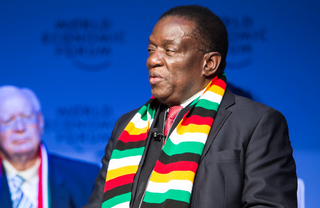News
A Weekend Together, Lives Apart — ‘Sailor’ Malan and ‘Shenge’ Buthelezi
There are parallels beyond this weekend, when one was buried in a ceremony with perhaps as many as 45,000 people, mostly Zulus, watching on amid pomp and ceremony in the presence of the great and the good; the other, where a handful of mostly white South Africans turned up to commemorate his death in Kimberley 60 years ago.


Over the past weekend, I attended two very different commemorations. Both subjects were South Africans who shaped the country’s destiny, both walked a strongly independent line and both have been inadequately understood.
One was a soldier, political activist and farmer; the other was a politician and traditional leader. Group Captain Adolph Gysbert “Sailor” Malan, DSO & Bar, DFC & Bar, Legion of Honour, Croix de Guerre (France), Croix de Guerre (Belgium); Prince Mangosuthu Gatsha “Shenge” Buthelezi.
Two people with seemingly little in common: one born into a poor farming household in the Cape in 1910; the other born into a royal Zulu home in 1928. One had an education, of a harsh sort, as a cadet at the General Botha Naval Academy aged just 14; the other had a life of relative affluence, a university education and political occupation. One forged a career as an outsider, of mixed Afrikaner-English stock, a colonial “Johnny” leading a British establishment, a renegade political leader going against the prevailing apartheid grain in the country of his birth; the other a racial and tribal insider who turned into an outsider, temporarily an insider once more after 1994, and then increasingly an outsider as the political wheel again turned.
But there are parallels beyond this weekend, when one was buried in a ceremony with perhaps as many as 45,000 people, mostly Zulus, watching on amid pomp and ceremony in the presence of the great and the good; the other, where a handful of mostly white South Africans turned up to commemorate his death in Kimberley 60 years ago.
“Sailor” Malan, so nicknamed because of his merchant maritime background, joined the peacetime Royal Air Force in 1935. Given the gathering war clouds, he was accepted only because of a relaxation in the age limits. “His visits to German ports were [a] significant moment in his life,” recalls his relative, the academic Dr Yvonne Malan. “He realised that war was imminent and, more importantly, that values that he held dear were at stake.”
This hints, too, at enduring traits, Malan notes, “of justice and fairness, and his dislike of bullies of any variety”. This may be related to his naval training, where floggings and endless hazing forged stoicism in an “establishment with a masculine drill regime that made Sparta look a place for milksops”, as Bill Nasson has put it.
In the bio-epic Battle of Britain, the character of Squadron Leader Skipper, played by the similarly lantern-jawed Robert Ryan, is fashioned on Malan. His disciplinarian, no-nonsense streak is apparent in the opening scene when, on landing at a grass strip in France, the polo-necked Skipper tells the ground crew to refuel his Hurricane and make it quick. When ignored by the airman, he snarls, “I don’t mean with your blood”. Malan was, Nasson notes, “a leader hard on himself and hard on his pilots”.
While Malan is known for his extraordinary gunnery skills, fearlessness and leadership of 74 Squadron — motto: “I fear no man” — which brought him a tally of 27 enemy aircraft destroyed, seven shared destroyed, two unconfirmed, three probables and 16 damaged, making him at the time the RAF’s leading ace, perhaps his greater contribution was in building a team around him and educating others about the tactics necessary to survive aerial combat.
Malan’s 10 rules of aerial combat, pasted then all over RAF bases, have stood, even today, the test of time:
- Wait until you see the whites of his eyes. Fire short bursts of one to two seconds and only when your sights are definitely “ON”.
- While shooting think of nothing else, brace the whole of the body, have both hands on the stick, concentrate on your ring sight.
- Always keep a sharp lookout. “Keep your finger out!”
- Height gives you the initiative.
- Always turn and face the attack.
- Make your decisions promptly. It is better to act quickly even though your tactics are not the best.
- Never fly straight and level for more than 30 seconds in the combat area.
- When diving to attack always leave a proportion of your formation above to act as top guard.
- INITIATIVE, AGGRESSION, AIR DISCIPLINE, and TEAMWORK are the words that MEAN something in Air Fighting.
- Go in quickly — Punch hard — Get out!
And then came perhaps Malan’s greatest contribution when, recognising the wear and tear the war had taken, he was transferred to the reserve in January 1942. That a man of his steely demeanour and undisputable courage could be taken off active flying duties recognised that everyone, even Sailor Malan, had their limits.
He had been on operations virtually without a break since September 1939. By August 1941 he had logged more than 200 combat flights.
“He knew he was overstrained, not normal,” writes his biographer Oliver Walker. “He did not think that his flying abilities were affected until one day when he was out on patrol and spotted a formation of Nazi fighters. He gave the order to make an attack and led it. Only after would he admit to himself that his approach had been tactically right, but morally wrong since it adversely affected the rest of the squadron.
“‘It’s hard to explain,’ he said. ‘I don’t know if I make the point clear. It was my reflexes, if you like. I knew I had made a mistake — a mistake I wouldn’t have made if I had been fresh. You don’t get the chance to make mistakes like that more than once.’ After an initial three-week break ‘suddenly I knew how really clapped-out I was.’”
When Malan reported back for duty, he had a spell of gunnery instruction and then a US trip with a fellow flying ace, Bob Stanford-Tuck, a tour which was part technical (in sharing the lessons of aerial combat, and flying the next generation of US machines) and part political in carrying out public relations with US “cousins”.
A switch of enemy
After the war, Malan resigned his commission and returned to South Africa, working as Harry Oppenheimer’s private secretary for a time, before turning to sheep farming at Benfontein outside Kimberley. His enemy shifted, too, to focus on the National Party (NP) government. Malan joined the liberal Torch Commando in political opposition to the NP, led by another Malan, Daniël François, who had once described the “enemy” as “the non-white” and “the Briton”. Malan recognised the dangers of such authoritarianism, as did many other white South Africans at the time.
In its heyday, the Commando drew rallies of 75,000 from its 250,000 members, representing not less than 10% of the white population at the time, and a third of them ex-servicemen. It was funded in part by Oppenheimer and the United South Africa Trust Fund, which drew contributions from mining houses and private individuals who saw no future in a South Africa under the Nats. Alan Paton, himself a member, remarked that the Torch was the only organisation the National Party ever feared.
But by the late 1950s, the Torch Commando had splintered in the face of ratcheting apartheid regulations and direct attacks on its members by the right and increasing ideological radicalism on the left.
As one former RAF officer, also a group captain and similarly decorated, said about Malan: “Legend. First wave every morning. Spike some Nazis. Then rest of the day running the Sqn. Awesome pair of hands. Britain is grateful.”
But is South Africa, for either or both these public figures?
Nasson, the celebrated historian, writes of Malan that his “relationship with an emerging apartheid utopia may be no less poignant. … At its low point, it would make him an ‘outsider’, a betrayal of another kind. As such, in the 17 years between his return to Cape Town and the end of his life, there would be much in his own country upon which he, in turn, would turn his back. Unlike the RAF,” concludes Nasson, “it was not an individual place in which he would almost invariably get his individual way.”
Buthelezi’s fight on two fronts
Malan had the moral clarity that came with fighting a fascist aggressor. For Buthelezi, the moral choices were more fraught. He was opposed, in his own way, to apartheid, but he was also determined to fight on two fronts, confronting what he saw as an equally dangerous threat — that of an armed liberation movement and its recidivist policies.

In the cauldron of KwaZulu-Natal in the 1980s, this battle would become steeped in blood. The Truth and Reconciliation Commission was not kind to Buthelezi, pointing out his links to the worst parts of the apartheid security establishment. But it was also critical of violence by other parties.
After apartheid, he and the ANC made peace although he continued to criticise it for its governance failings. He played no small part in entrenching the culture of democratic opposition.
Perhaps this is what President Cyril Ramaphosa was getting at when he acknowledged all the opposition leaders present, during the second half of the Buthelezi ceremony, when it clumsily shifted from a rich, personal event led by the church and the family, to a “Level 1 Official State Funeral”, as mourners were regularly reminded.
The President presumably was trying to highlight the ANC’s tolerance of the diversity of political actors, but this smacked of an ex-post explanation of the violence that had gripped the province in the 1980s and 1990s, and which simmers today. Anyway, this explanation appeared to enjoy little resonance with many in the Amabutho, or regiments, who, by this stage, were getting up to leave in their groups in the infield of the stadium.
While Buthelezi might have been acknowledged in death, this honour has so far eluded Malan. Due to his prominent role in opposition to apartheid, the Nationalist government sought to downplay his funeral, refusing him military honours, and even not permitting serving members to attend in uniform, while the SA Air Force was instructed not to give him any tribute.
Agency still matters. The current regime did not attend Malan’s most recent celebration, despite being invited, whatever his anti-apartheid role and global contribution. Yet his is a name that was and still is celebrated around the world given his role, like the Spitfire in which he scored his victories, symbolising a mood of stubborn defiance during the darkest days of Hitler’s tyranny. And so too should his name be celebrated in South Africa today, as inconvenient as his racial agency, sadly, may be viewed.
The ANC’s history of Buthelezi will not be kind either, despite the “Level 1” state funeral status.
The arena of politics demands heroes and villains. Both ceremonies teach us that any assessment of the integrity of the individual under scrutiny is no less subjective and politicised than the morality of those making the judgment.
This article originally appeared on the Daily Maverick
Photo: Gallo Images/Wikipedia


